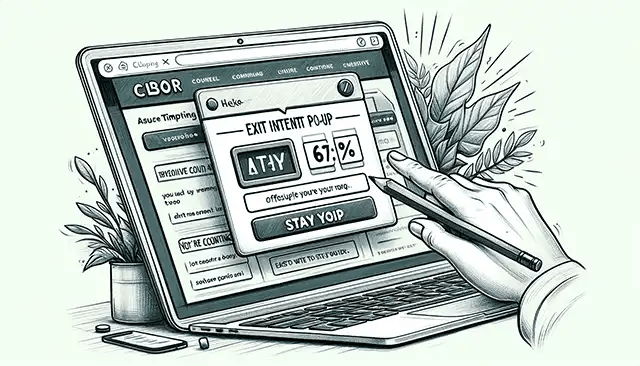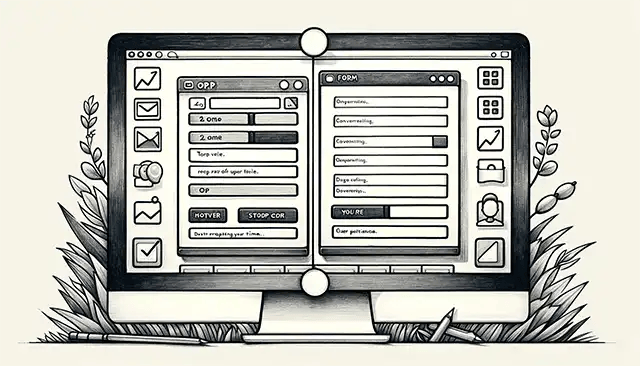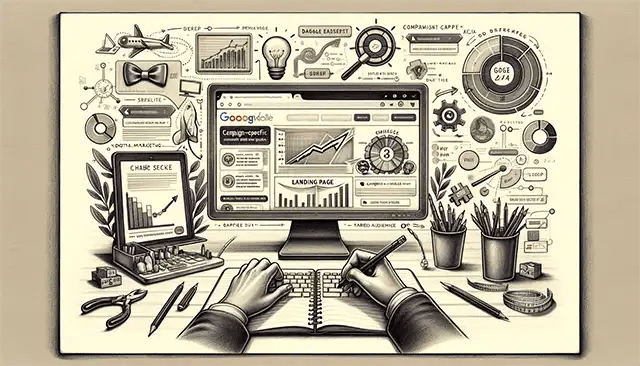Maximize Profits: Key Conversion Optimisation Strategies
- Home
- Maximize Profits: Key Conversion Optimisation Strategies
Let's face it, turning website traffic into paying customers is no walk in the park. That's where Conversion Optimization Strategies come into play—those crucial tweaks and tests that transform your site from a digital ghost town to a bustling marketplace. You're about to dive deep into proven tactics to help increase conversion rates like leveraging exit intent pop-ups for lead capture, harnessing live chat for real-time engagement, understanding how form length affects conversion rates, creating campaign-specific landing pages, a/b tests and optimizing acquisition channels.
With stats in hand—from boosting conversions by up to 10% with well-timed pop-ups to increasing them by 45% through engaging live chats—you'll get actionable insights on ramping up those numbers. Ready? Let’s build a conversion rate optimization strategy and turn visitors into customers together.
Table Of Contents:
- Leveraging Exit Intent Pop-Ups for Lead Capture
- Integrating Live Chat for Real-Time Engagement
- The Impact of Form Length on Conversion Rates
- Creating Campaign-Specific Landing Pages
- Optimizing Acquisition Channels for Higher Conversions
- FAQs About Conversion Optimization Strategies
- Conclusion

Leveraging Exit Intent Pop-Ups for Lead Capture
A visitor is about to leave your site, and just then, a pop-up swoops in with an offer they can't ignore. That's the power of exit intent pop-ups at work—a strategy that can increase conversions and turn would-be goodbyes into profitable hellos.
Crafting Compelling Offers in Pop-Ups
You've seen it before—the countdown timer offering a discount if you sign up now or the promise of exclusive content delivered straight to your inbox. But what makes these offers not just click-worthy but also type-in-your-email-worthy? It's all about value. If you're promising a free resource, make sure it’s something so irresistible that visitors are willing to trade their precious email addresses for it.
The key here isn’t just slapping on any old incentive; it's finding the sweet spot between what you want (their contact info) and what they need (a reason compelling enough to give it). So let me tell you—offering discounts works wonders because who doesn't love saving money? And when we talk stats, reports show using such tactics could bump up conversions by 5-10%. Now imagine harnessing even half of that potential—it’s like hitting lead generation gold. This is one part of the CRO process.
Designing Visually Appealing Pop-Ups
We eat with our eyes first—even when digesting digital offers. To improve your website's conversion rate your pop-up needs more than a snazzy copy; its design should scream "Look at me." without being an eye sore. Clashing colours on a CTA button or a phone number with fonts harder to read than hieroglyphics will send those potential leads running faster than kids from vegetables.
Here’s where harmony comes into play—colour palettes complementing your website scheme and clear yet attractive typography speak volumes in the silent language of design appeal. To improve your website's performance think clean lines over cluttered chaos; think ‘easy on the eyes’ graphics that invite engagement rather than confusion or frustration.
Best Practices for Timing and Frequency
To encourage visitors to stay a well-timed exit-intent pop-up is like catching someone right before they step out the door—with one last pitch that could change everything. You don’t want them popping up every few seconds—that’s akin to having someone jump out from behind furniture repeatedly while trying to have a calm conversation.
Balancing timing is crucial to the optimization process when you want to improve conversion; setting triggers based on user behaviour ensures your message appears exactly when there's a maximum chance of conversion without being annoyingly frequent. For instance, consider rolling out red carpet invites once evidence suggests interest waning via scrolling speed or mouse movement towards the 'close tab' button – inviting guests back into the party instead of picking coat check time too early is a great CRO strategy.
Exit intent pop-ups can transform near exits into new leads by swooping in with irresistible offers. Create value-packed deals to get visitors' emails, like discounts or exclusive content. Make sure your design grabs attention and matches your site's vibe without being overbearing. Lastly, time these pop-ups just right—catch users before they bounce but don't annoy them.

Integrating Live Chat for Real-Time Engagement
If you've ever felt the frustration of browsing a website and needing help that just wasn't there, then you understand why live chat is revolutionizing customer service and helping to convert visitors. Imagine giving your existing website visitors the power to get their questions answered on the spot—that's what live chat does, and it’s making waves in boosting conversion rates.
Training Your Team for Effective Live Chat Communication
Before unleashing this powerful tool on your site, make sure your team is up to snuff. They need to be quick on their feet—or fingers—to engage with potential customers effectively. A staff member who can combine speed with charm? That's gold right there. It turns out that having someone ready to answer queries at lightning speed can hike up those conversions by as much as 45%. But remember: a fast response time alone won’t cut it if the quality isn't there.
Your team needs training not just in typing skills but also in empathy and product knowledge so they're prepped for anything thrown their way—be it an easy question about shipping or a tougher one about product features. This sort of preparation doesn’t only prevent awkward pauses; it fosters trust—and we all know trust translates into sales.
We’re talking real people offering real-time solutions here; no robots allowed. When folks are cruising through your online store or wrestling with decisions over which services suit them best, nothing beats human connection.
Fostering Immediate Trust Through Personalized Interactions
The beauty of live chat lies in its ability to give users personalized attention without delay—something that simply cannot be matched by email or phone calls where responses may lag behind user expectations causing bounce rates rather than conversation rates to soar.
Paying close attention during these interactions goes miles toward building rapport quickly because let's face it—we buy from businesses we like.
Avoiding Common Pitfalls: Not Just About Being There but Being Helpful
Sure, slapping a live chat feature onto your site seems like an instant fix for sluggish conversions—but hold on now. If poorly executed (think long wait times), this could backfire big time sending frustrated would-be buyers straight out of that shopping cart lane faster than you can say "abandoned purchase."
"Hey Siri," asks nobody ever while navigating a well-optimized site armed with efficient live chat support...
This functionality should integrate seamlessly into user experience design creating such smooth sailing through information gathering phases potential customers feel more confident taking specific actions whether subscribing, joining, downloading or buying—you name 'em.
But when done right? Oh boy—it's like opening a treasure chest. You'll find all sorts of valuable insights tucked away, just waiting for you to discover them.
Live chat can skyrocket conversions by up to 45% when your team combines quick, charming responses with deep product knowledge and empathy. Just remember, a smooth live chat experience is more than speed—it's about creating human connections that build trust and make people want to buy from you.

The Impact of Form Length on Conversion Rates
When it comes to converting site visitors into leads, the length of your lead forms plays a surprisingly pivotal role. Imagine you're at a party and someone asks for your life story versus just your name—it's the same online with form submissions. The balance between asking too much or too little can be like walking a tightrope.
Balancing Information Gathering with User Patience
We've seen that longer lead forms, those multiple-field gatekeepers to user engagement, can potentially convert up to 13% more than their shorter counterparts. This statistic is compelling but let’s not jump the gun here; we have user experience to consider as well. You want sufficient data from potential customers without making them feel like they’re filing taxes instead of simply showing interest in what you offer.
User patience isn't infinite—far from it. Each additional field on your form is another hurdle for conversion rate optimization (CRO). It's crucial to ask only what's necessary because each question has its cost—a concept every marketer should engrave in their mind when crafting an optimization strategy for conversions.
But how do we find this sweet spot? A/B testing will come in handy here—like trying different spices until you perfect that chilli recipe everyone raves about at cookouts. With split tests comparing short and long forms side by side, one begins painting a picture of which fields are essential and which might be causing visitors complete exhaustion rather than excitement about your product offering.
Crafting Forms That Convert Without Fatigue
To boost conversions effectively while respecting our visitor’s time, think minimalism meets practicality—only gather info that aligns directly with conversion goals so every field earns its keep on the page.
A tip straight out of my own CRO tool kit: To build a great conversion funnel use progressive profiling where subsequent interactions gradually collect more information over time—an elegant dance rather than an interrogation under harsh lights. By doing this, we foster trust and avoid overwhelming new acquaintances who aren’t ready to spill all their secrets yet—or ever.
Personalization Meets Precision: Targeted Questions for Better Leads
Leveraging personalization techniques doesn't just apply after getting contact details—it starts right there within the form itself. Segment questions based on previous interactions or specific actions taken by site visitors allow us to tailor our approach even before saying hello through email campaigns or phone calls down the line—and could very well lift that conversion rate average above industry report standards.
Keep forms short and sweet to respect your visitors' time, balancing data collection with user patience. Test different form lengths to find the perfect mix that gathers essential info without causing fatigue. Try progressive profiling—collect more details over time rather than all at once.

Creating Campaign-Specific Landing Pages
you're crafting a tailored suit. Every stitch aligns with the wearer's measurements for that glove-like fit. Now, apply that same bespoke concept to your digital marketing strategy—this is where campaign-specific landing pages come into play.
Personalizing Content for Different Target Audiences
You've heard it before; personalization is king in the realm of digital marketing. But why? Because when potential customers feel like you're speaking directly to them, they listen—and more importantly—they act. A generic page may speak volumes about your product offering but whispers nothing personal to the visitor.
Campaign-specific landing pages let you craft messages pinpointed at various segments of your target audience. Think of it as having a unique handshake with each customer group—one size does not fit all here. When visitors land on a page mirroring their expectations and needs, fostered by ad copy they just clicked through, magic happens—their trust deepens and their wallets often open.
Digital marketers have found that when content resonates deeply due to its targeted nature, relevance skyrockets along with lead nurturing capabilities—it’s no wonder these custom-fit pages can work wonders on conversion rates.
Analyzing Channel Performance with Google Analytics
If acquisition channels were roadways leading customers to your business online, wouldn't you want traffic reports? That's what Google Analytics provides—a GPS guiding towards sustainable growth by highlighting which roads are clear and which ones need work.
Fine-tuning these pathways means delving into data showing how different audiences interact across channels—from social media prowess bringing organic traffic streaming in from Twitter feeds or Facebook posts to search engine optimization drawing curious clicks via keyword-laden blog post links scattered across cyberspace.
The goal isn't just improving numbers; it’s understanding behaviours behind those numbers so we can replicate success stories time after time without missing a beat (or click). By leveraging insights gleaned from analytics tools strategically paired up against each channel’s performance stats—the journey toward better conversion rate averages becomes less guesswork and more precision engineering.
Craft campaign-specific landing pages like a tailor-made suits—each one uniquely fitted to different customer groups. This personal touch boosts trust and opens wallets.
Dive into Google Analytics as if it's your GPS for growth, guiding you to understand and improve how each channel performs in drawing customers to your business.

Optimizing Acquisition Channels for Higher Conversions
Imagine a bustling marketplace where every stall vies for attention. That's your online landscape, with acquisition channels as the stalls. Your goal? To draw in customers and not just have them browse but buy, subscribe or fill out that form. We're talking about honing these pathways to make sure they lead straight to conversions. Remember, for a good conversion rate, back this up with detailed case studies and customer reviews to provide the social proof needed.
Analyzing Channel Performance with Google Analytics
The digital footprints left by visitors on your site are like breadcrumbs. They tell you where each visitor came from before landing on your page—be it through social media, organic traffic from search engines, direct visits, or referral links. With Google Analytics, we can trail these crumbs back to their sources and figure out which ones are leading people to take desired actions.
To begin dissecting this data feast served up by Google Analytics, focus on the 'Acquisition' section. Here you'll find how sustainable growth is tied directly to how well you understand and optimize these acquisition channels; because let’s face it: some paths will be paved with gold while others might need paving over.
A deep dive into channel performance reveals more than just numbers—it uncovers stories of customer journeys that either end in cheers (conversions) or tears (bounces). Say one channel has an impressive click-through rate but falls flat when it comes down to actual conversions—you've got a clue there's something amiss between attraction and action.
Harnessing High-Performing Channels for Sustainable Growth
We all love being winners; so when certain channels show they’ve got what it takes by driving high conversion rates—give them the trophy. This isn’t about playing favorites though; this is strategic amplification based on cold hard stats telling us which platforms help potential customers complete that coveted specific action whether purchasing from an online store or signing up for a newsletter.
This means shifting budgets towards proven performers while tweaking—or pausing—the underperformers after careful consideration of factors like bounce rate average versus conversion goals achieved per platform. It’s kind of like coaching a sports team—you want everyone performing at their best position.
Leveraging Insights Beyond Surface-Level Data
Gaining insights goes beyond simply looking at total number counts next to each channel name in Google Analytics reports; consider also engagement metrics such as pages per session and average session duration along with those conversion rates we keep harping about because they paint pictures regarding user experience quality across different touchpoints within your website's functionality spectrum.
Digging even deeper involves assessing not only what is on the surface but also uncovering the underlying elements that aren't immediately visible. This meticulous approach often reveals insights that are critical for a comprehensive understanding.
To spike your conversion rates, think of your acquisition channels as a competitive marketplace. Use Google Analytics to track where visitors come from and focus on the winners—those driving high conversions. Shift budgets there, tweak or pause the rest, and always dig deeper than surface-level data for insights that guide smart moves.
FAQs About Conversion Optimization Strategies
What are the 6 primary elements of conversion rate optimization?
The big six: compelling value proposition, intuitive site navigation, optimized checkout process, persuasive content, trust signals, and continuous testing.
What are the steps of conversion optimization?
Dig into data. Hypothesize changes. Test variations. Analyze results. Optimize further or implement successful tests.
What is the best conversion strategy?
A solid gold tactic blends irresistible offers with laser-focused targeting and relentless A/B testing to keep improving.
What are the 4 steps of conversion?
Catch their eye; pique interest; spark desire; prompt action – that's your ticket to convert browsers into buyers.
Conclusion
Remember, conversion optimization strategies are your ticket to higher profits. Think exit intent pop-ups and that sweet spot between annoyance and opportunity—they're your friends for capturing leads as visitors head for the door.
Keep in mind, live chat isn't just a buzzword; it's about forging connections on the fly, and turning queries into sales with real-time support. That 45% boost? It’s within reach.
Bear this in mind: forms can make or break you. Balancing detail with brevity is key—more fields might mean more conversions if done right.
Dive deep into personalization too. Those campaign-specific landing pages aren’t just pretty faces; they resonate deeply with your audience when aligned correctly.
And don't forget channels—the lifeblood of acquisition. Analyzing their performance can lead you straight to where conversions thrive best.


